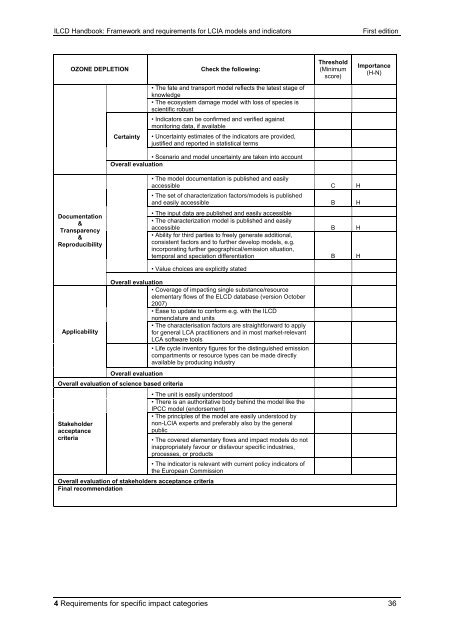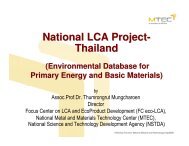ILCD Handbook: Framework and requirements for LCIA models and ...
ILCD Handbook: Framework and requirements for LCIA models and ...
ILCD Handbook: Framework and requirements for LCIA models and ...
You also want an ePaper? Increase the reach of your titles
YUMPU automatically turns print PDFs into web optimized ePapers that Google loves.
<strong>ILCD</strong> <strong>H<strong>and</strong>book</strong>: <strong>Framework</strong> <strong>and</strong> <strong>requirements</strong> <strong>for</strong> <strong>LCIA</strong> <strong>models</strong> <strong>and</strong> indicators First edition<br />
OZONE DEPLETION Check the following:<br />
Documentation<br />
&<br />
Transparency<br />
&<br />
Reproducibility<br />
Applicability<br />
Certainty<br />
• The fate <strong>and</strong> transport model reflects the latest stage of<br />
knowledge<br />
• The ecosystem damage model with loss of species is<br />
scientific robust<br />
• Indicators can be confirmed <strong>and</strong> verified against<br />
monitoring data, if available<br />
• Uncertainty estimates of the indicators are provided,<br />
justified <strong>and</strong> reported in statistical terms<br />
• Scenario <strong>and</strong> model uncertainty are taken into account<br />
Overall evaluation<br />
Threshold<br />
(Minimum<br />
score)<br />
• The model documentation is published <strong>and</strong> easily<br />
accessible C H<br />
• The set of characterization factors/<strong>models</strong> is published<br />
<strong>and</strong> easily accessible B H<br />
• The input data are published <strong>and</strong> easily accessible<br />
• The characterization model is published <strong>and</strong> easily<br />
accessible B H<br />
• Ability <strong>for</strong> third parties to freely generate additional,<br />
consistent factors <strong>and</strong> to further develop <strong>models</strong>, e.g.<br />
incorporating further geographical/emission situation,<br />
temporal <strong>and</strong> speciation differentiation B H<br />
• Value choices are explicitly stated<br />
Overall evaluation<br />
• Coverage of impacting single substance/resource<br />
elementary flows of the ELCD database (version October<br />
2007)<br />
• Ease to update to con<strong>for</strong>m e.g. with the <strong>ILCD</strong><br />
nomenclature <strong>and</strong> units<br />
• The characterisation factors are straight<strong>for</strong>ward to apply<br />
<strong>for</strong> general LCA practitioners <strong>and</strong> in most market-relevant<br />
LCA software tools<br />
Overall evaluation<br />
Overall evaluation of science based criteria<br />
Stakeholder<br />
acceptance<br />
criteria<br />
Overall evaluation of stakeholders acceptance criteria<br />
Final recommendation<br />
• Life cycle inventory figures <strong>for</strong> the distinguished emission<br />
compartments or resource types can be made directly<br />
available by producing industry<br />
• The unit is easily understood<br />
• There is an authoritative body behind the model like the<br />
IPCC model (endorsement)<br />
• The principles of the model are easily understood by<br />
non-<strong>LCIA</strong> experts <strong>and</strong> preferably also by the general<br />
public<br />
• The covered elementary flows <strong>and</strong> impact <strong>models</strong> do not<br />
inappropriately favour or disfavour specific industries,<br />
processes, or products<br />
• The indicator is relevant with current policy indicators of<br />
the European Commission<br />
Importance<br />
(H-N)<br />
4 Requirements <strong>for</strong> specific impact categories 36



